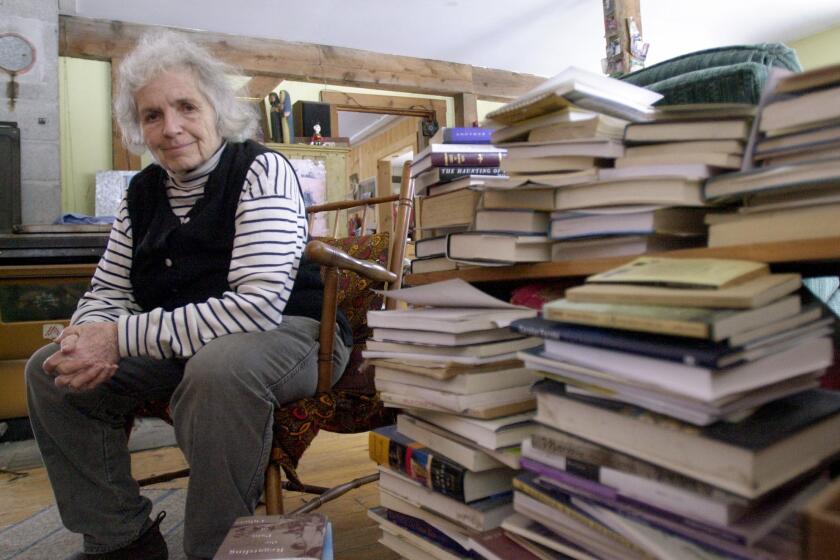Private lives
ALTHOUGH the golden garland of the Nobel Prize for Literature has sometimes been the kiss of death for the development of a writer’s art, that has certainly not been the case with South Africa’s Nadine Gordimer. Since receiving the Swedish accolade in 1991, she has kept up her customary output of novels, interspersed with short-story and essay collections. And there has certainly been no diminution in either the variety or quality of her work. Like her near-contemporary Doris Lessing, who grew up in Southern Rhodesia (now Zimbabwe), she just seems to get better and better with age, producing work that is more profound, more searching, more accomplished than what she was writing earlier in her long and distinguished career.
Born outside Johannesburg in 1923, Gordimer has lived in that sprawling, gold mining megalopolis all her life. Her latest book -- “Get a Life,” her 14th novel -- like so much of her fiction, is set there. An uncommonly precocious writer, Gordimer published her first short story in her early teens, and it is more than half a century since readers in the New Yorker first began to encounter the lapidary fiction that was to establish her reputation.
What set Gordimer apart immediately from other South African writers of the time was that the response she elicited from readers was not due to a fascination with the exotic. Rather, it was the shock of encountering the familiar halfway across the globe, for Gordimer was writing about situations and dilemmas -- social, sexual, familial -- akin to those in the world of upper-middle-class American readers of the New Yorker.
Now, at 82, having had the satisfaction of seeing the transition of her fractured nation into a true multiracial democracy and finding herself liberated from the duty toward political fiction that dominated her writing during the increasingly hideous turmoil of apartheid, Gordimer arrives back where she started.
“Get a Life” is reminiscent of such early Gordimer short-story collections as “The Soft Voice of the Serpent” and “Friday’s Footprint.” This novel explores a world of high-tech medical treatment, of trendy restaurants, of high-pressure jobs in public relations or in business or in the medical and legal professions, of globetrotting to conferences or vacations in far-off locations, of conspicuous consumption juxtaposed with a mild but genuine concern for ecology, conservation and social justice. In short, the world of the decent, privileged upper-middle classes anywhere.
Of course, it does take place in present-day Johannesburg and, just as Gordimer’s apartheid-era fiction bore the societal imprints of that rebarbative system, so “Get a Life” provides glimpses of the “New South Africa’s” oligarchic inequalities and iniquities. Where else but in South African fiction would the role of a servant have a function so crucial to the domestic dynamic of a family crisis? Even the greatest of upheavals leave some things changed but little.
Politics hover on the edges of this novel. References are made to actual events, but even the most pressing problems of contemporary South Africa operate here as agents for furthering plot and highlighting character. We see the elaborate high-tech apparatus that enables the privileged for the most part to keep the sinister underclass at bay, but when there is a breach of security the consequences are comic rather than tragic; the effect of the incident is to spotlight the potential for reexamination and reversal of accustomed roles.
Similarly, South Africa’s appalling AIDS crisis surfaces here as an opportunity for the well-intentioned, open-minded, charitable and liberal folk who populate the novel to take in an HIV-positive orphan. The inexplicable hostility of South Africa’s president and his administration to antiviral drugs, to say nothing of the horrific demographic consequences that the disease has the potential to bring about, remain deep in the background of “Get a Life,” which rings with Gordimer’s determined optimism about her miraculously reborn country.
Get a life -- that harsh injunction flung at people whose interference is annoying -- becomes in Gordimer’s hands an apt suggestion for many of the characters in her novel. First and foremost, it applies to Paul Bannerman, a 35-year-old ecologist who finds that his post-surgical treatment for thyroid cancer leaves him literally too hot for his wife and child to handle. He is in fact so radioactive that he is dangerous to those around him, at least for a while, so his parents, who don’t care about the risk, take him into their house.
Is this Gordimer’s attempt at magic realism? No, apparently it is the actual consequence of a real medical procedure, but the brevity of the period in which he is so toxic is the one weakness in this situation: It turns out to be for only a few weeks -- which might make some readers feel the situation is just a little contrived.
But there is certainly nothing forced about the chain of events that flows from this crisis, as other characters also get different lives. The ripple effect is noticeable -- not only in Paul’s marriage and in his relationships with everyone from his family to his colleagues at work but also in the lives of his devoted, staunch parents.
There’s nothing at all predictable about what happens: It’s not as if the parents are felled by radiation sickness or cancer. What transpires is more subtle: “It turned out to be real that the inconceivable can become routine. At least as far as contact is decreed. Relationships. Their new nature, frequency, and limits.”
First we see the devastating consequences of the treatment, not merely Paul’s isolation but his punishing fatigue: “He cannot lift the hand, no device of the millennial gods of communication could reach across infinitude between how he lies and the module console-desks, Corbusier lookalike chairs, leather sofas.... “
As the novel progresses, the reader starts learning intimate secrets about the Bannermans, senior and junior, which render them, and their marriages, increasingly complex and fascinating.
What strikes the reader most after all these decades of Gordimer’s writing is the way she has evolved from a merciless dissector of situations and emotions, coolly and analytically discussed and exposed, into a novelist capable of creating such richness of character development as in this latest book. And how her imagination roams, illuminating such a variety of feelings and experiences. What warmth, what understanding of what really goes on under the skin, in the minds, the hearts, the guts, the genitals of her characters.
There is an almost palpable sense of engagement with these people and their world which leads the reader to recognize that here is an author very much in touch with the present and even capable of reaching into the future. A tour de force for any writer but surely still more remarkable in an octogenarian. There is no sense of retrospection here: “Get a Life” is, in every sense of the expression, a novel that is truly with it. *
*
From Get a Life
WHAT do you do when you have no purpose, are allowed no purpose but something his mother has called “recuperate.” ... He could not really believe he was going to have to die, rogue cells were moving around right now within the territory of himself; dying is a remote business, has no reality when you are in your thirties, all that can happen is you’re run over by a bus. Shot by a hijacker....[W]hat he’s wanted to know from early on when he was told the gland must be removed, is what his life would be without it. He was told not to worry, let’s just beat the cancer. You’ll take some routine medication.
More to Read
Sign up for our Book Club newsletter
Get the latest news, events and more from the Los Angeles Times Book Club, and help us get L.A. reading and talking.
You may occasionally receive promotional content from the Los Angeles Times.





